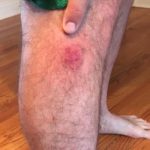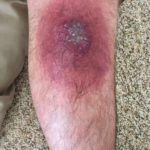Brown Recluse Spider Bite
History of present illness:
A 31-year-old male with past medical history of type 1 diabetes mellitus presented to an emergency department in New Jersey for evaluation of a lesion on his right calf. On the day prior to noting the lesion, he recalled seeing a spider on his leg. The patient described the lesion as a small area of erythema that rapidly expanded (Day 1 09:00 and Day 1 16:00). On day two, the wound developed central necrosis with purulence and was associated with rigors and a maximum fever of 38.3°C. The patient presented to the emergency department (ED) on day 4 (Day 4 and Day 4B).
Significant findings:
Examination of the skin revealed erythema and induration on the right lateral leg 12 cm in diameter with a 6 cm area of central necrosis and surrounding petechiae without fluctuance or crepitus. The patient was neurovascularly intact distal to the lesion. Laboratory values were within normal limits, except for an elevated C-reactive protein (5.31 mg/dL, normal range <0.70 mg/dL). The patient was diagnosed with ulceration secondary to envenomation from a brown recluse spider.
Discussion:
Brown recluse spiders (see image) are identified by a violin-shaped mark on the dorsal thorax and typically found in the central United States from April to October,1 although there are reports of brown recluses being identified as far east as Pennsylvania and north as Minnesota. Since brown recluse spider bites are typically due to spiders defending themselves, rather than aggressing towards a predator, there is usually one focal lesion.1
The spider venom contains sphingomyelinase, which causes local ischemia and destruction of the capillary bed and results in an initial central area of pallor that becomes necrotic in one to two weeks.1,2 Loxoscelism, the effect of the spider venom, can present as a local cutaneous lesion, or develop into systemic symptoms, which are broad and can include weakness, fatigue, hemolytic anemia, thrombocytopenia, and coagulopathy. In severe systemic cases, patients can develop a coagulopathy and maculopapular rash, which typically respond to steroids. Wounds may take up to three months to heal, although require no more than conservative treatment with aggressive wound care, such as debridement and frequent dressing changes.1 In rare cases, wounds can be associated with hemolytic anemia, severe thrombocytopenia, or can require skin grafting.1-3 In a large retrospective study of over 2500 recorded cases, 57 patients developed systemic loxoscelism.5 Of those, approximately one half acquired a hemolytic anemia and less than one fifth developed sepsis. In one study of 111 patients with brown recluse spider bites, only three patients required skin grafting and one patient developed hemolysis.3 There are some small studies that suggest that the use of dapsone may decrease the need for surgical intervention due to its inhibitory effect on leukocytes.4 Nevertheless, these effects were demonstrated only in animal models and evidence suggests that the risks of dapsone, such as aplastic anemia, may outweigh its benefits.3,6Due to the limited nature of data for the outcomes of spider bites, there is insufficient information to give clear recommendations as to management strategies beyond standard wound care.
There is no clinically available diagnostic test to confirm brown recluse spider bite. In this case, the patient had good wound healing with standard wound care after approximately three weeks and no long-term sequelae.
Overall, it is important for emergency medicine physicians to consider this diagnosis in patients who present with necrotic lesions because they can be easily be confused with simple skin infections or with other insect bites. Although the management of a brown recluse spider bite is not significantly different from other bites, antibiotics are generally unnecessary, and patients should be counseled to be aware of the potential for subsequent bites if they live in a wooded environment.
Topics:
Brown recluse spider, insect bite.
References:
- Stoecker WV, Vetter RS, Dyer JA. NOT RECLUSE – a mnemonic device to avoid false diagnoses of brown recluse spider bites. JAMA Dermatol. 2017;153(5):377-378.
- Juckett G. Arthropod bites. Am Fam Physician. 2013 Dec 15;88(12):841-7.
- Wright SW, Wrenn KD, Murray L, et al. Clinical presentation and outcome of brown recluse spider bite. Ann Emerg Med.1997; 30:28-32.
- Robinson JR, Kennedy VE, Doss Y, et al. Defining the complex phenotype of severe systemic loxoscelism using a large electronic health record cohort. PLoS One.2017;12(4): e0174941.
- Rees RS, Altenbern DP, Lynch JB, King LE. Brown recluse spider bites: a comparison of early surgical excision versus dapsone and delayed surgical excision.Ann Surg, 1985;202:659-663.
- Bryant SM, Pittman LM. Dapsone use in loxosceles reclusa envenomation: is there an indication? Am J Emerg Med.2003 Jan;21(1):89-90.
- Parsons, M. # 1125.Centers for Disease Control and Prevention. Atlanta, GA: CDC; 1966. phil.cdc.gov/Details.aspx?pid=1125. Public domain.







